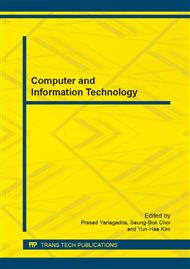p.216
p.222
p.227
p.231
p.236
p.241
p.245
p.250
p.257
Research of Improved Network Access Authorization Mechanism Based on Elliptic Curve
Abstract:
Currently, the generic WLAN authentication protocols have the problem of low security intensity, or the problem of only one-way identification. It cannot completely adapt to the wireless LAN access certification requirements, under the condition of high security. The article analyzes the disadvantage of WAPI protocol, and then puts forward a kind of improved WLAN access authentication mechanism. It implements the mutual authentication, privacy protection, and also it can resist man-in-the-middle attack and impersonation attack. It fulfills the requirement of wireless terminals security access. The effect on security and efficiency is analyzed.
Info:
Periodical:
Pages:
236-240
Citation:
Online since:
February 2014
Price:
Сopyright:
© 2014 Trans Tech Publications Ltd. All Rights Reserved
Share:
Citation:


